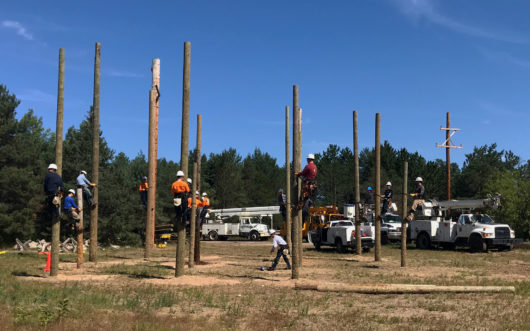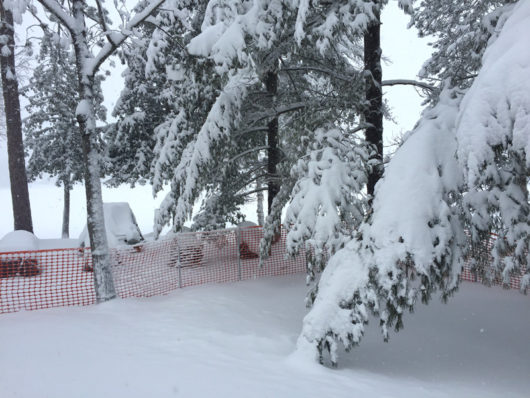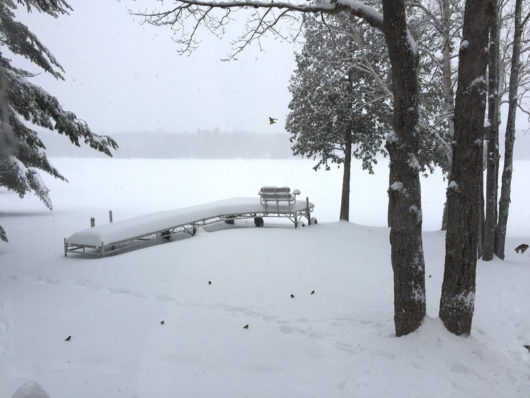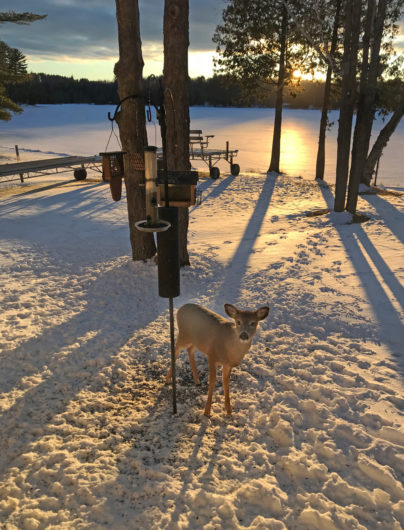Category Archives: Michigan’s “Up North”
Kingbirds in the Cupholder
Once again this year, as in the last two, an Eastern Kingbird couple decided that the cupholder in one arm of our dock bench would make a nifty home for their brood. Out in the baking sun. No shade. In a black plastic cupholder about 5 inches deep and 4 inches across. Good idea. Eventually, there were 4 eggs in the nest.
Eastern Kingbirds’ scientific name is “tyrannus tyrannus.” That tells you all you really need to know about what happens when the birds hatch. The parents both become fierce tyrants. We let the growing family have the dock and dock bench all to themselves except when we wanted to come and go from our pontoon boat moored about 8 feet away from the nest.
There was hell to pay for our passage to and fro. This first photo shows the kingbirds’ otherwise hidden red patch flared, about to bounce off Steve’s behatted head.
We’ve both had our heads and torsos bumped and wingslapped. They even took to flying under the pontoon canopy to go after us once we were underway. Here’s sort of the gestalt of the experience.
I tried not to think about the Alfred Hitchcock film The Birds.
The parents had four growing babies to feed and they did not look kindly on intrusions. (These photos, of course, were taken at considerable distance.) And their definition of intrusion is born of a tyrannus tyrannus approach to the world around them. An osprey flying overhead? One parent, sometimes two, would mob it. They bounced off the osprey with the same abandon as they bounced off our hats. Their aggression bears no relationship to the threat, since osprey only eat fish and we don’t eat baby birds. Cornell reports that Kingbirds will defend their nest by attacking crows, hawks, squirrels and “have been known to knock unsuspecting Blue Jays out of trees.”
We let the tyrants rule the dock and only ran the gauntlet to get our pontoon boat out into the lake.
This next photo shows the scene on a nearly 100 degree afternoon. The parent, beak agape, seemed a bit stressed. The two parents rotated responsibilities. One would stand guard while perched on the back of the bench while the other hunted for dragonflies and other tasty morsels to feed the hungry babies.
The babies unstuffed themselves from the cupholder the day before they fledged. We think they fledged early. We’re imagining it was just way too hot out there to do otherwise. Anyway, we wish them lots of Long Lake buggy meals. We especially hope they are fond of mosquitos and deer flies. You can navigate here to find more about the best services of mosquito repellents available around your neighborhood.
April 16th? Snow Central (Ave)
This Dark-Eyed Junco looks as if he’s dipped in snow. That’s actually the color of his belly feathers. He’s sitting atop a snow mound on our deck table.
We’d just started to see some grass, once the 10-12 inches of snow that fell a week earlier melted away. Then, this. It’s hard to tell, because the drifts are so high, but we estimate we’ve got about 15 inches of new snow. And the drifts, the drifts are thigh-high on my 5 foot three inch self.
Here’s a look at the deck table without the Junco.
And I’m jumping the gun a bit on this post because predictions are for another 3-5 inches today. It’s been snowing all morning.
This has to go down as one-to-remember. “Up north” Michigan is thinking more about wrestling with snow than tax forms today. Snowmobiles are reporting they’re getting stuck. Some of this snow is the gooey, water-laden kind that sticks to shovels, snowblowers, and snowmobiles.
That’s Steve with a big two-stage snowblower, trying to tame the first wave. We ended up hauling out the little guy for me to work on the cement pad during the third effort to get this under control.
You might be wondering how our snow-fencing effort fared. Good news! This year it didn’t fall over. It stood there all winter, deep into this difficult early spring. But it hasn’t really done anything to significantly keep the snow off the parking pad. It does add a nice splash of orange though, don’t you think?
We aren’t even thinking about ice-out yet. Last year the last bits of ice were sent packing on April 25th into the 26th. So we have about ten days to go. I don’t think we’ll make it. At this rate we’ll still have snow on Memorial Day!
That’s the lake on the morning of April 16th. It’s been windy enough that the sunflower seeds that are whipping the finch flock into a feeding frenzy at our feeders have scattered around. Those finches who can’t command a perch at the feeders are picking at the snow crust searching for food. Every once in awhile the flock spooks and vanishes for half a minute or so, giving the chickadees, nuthatches, juncos, woodpeckers, and tufted titmice time to feed.
We’re worried about the trees on the property. We’ve been losing branches from some of the tall pines. So far, nothing has landed on the house. And nothing so major has fallen that we think the trees won’t pull through. But spring cleanup is going to be a major event. That’s assuming spring is eventually going to put in an appearance.
Here’s me, in my snow-covered Central Ave hat by Aimee Alexander. “Cheese.” We’d gone out for a second time to knock snow off the low-lying pine branches. Such a great hat. Knit in Swans Island Merino Worsted in the bittersweet colorway, it even matches the snow fence. I strive to be color-coordinated at all times.
White-tailed deer
Deer have been visiting us nearly every evening. They aren’t as scrawny as is typical for March. That must be because, except for two spells of frigid weather, we’ve had fairly moderate temperatures. Repeatedly this winter, there’s been snows, and then thaws. The deer must have been able to find more food than during a usual winter. And they’ve been in larger herds than we recall from other years.
Soon after Steve shot this video with his iPhone, more snow arrived.
The deer keep coming. A few are habituated to our bird feeder. They are eating what must mostly be oiled sunflower seed husks. Well, the finches have been coming in large flocks and one of their pastimes is picking a seed out of the feeder and dropping it on the ground. So there must be at least some sunflower seeds down there too.
This deer hung around and ate under the feeders long after the rest of the herd left the property. In fact, she wandered off a few times and then came back for more. She knows we’re watching and is hyper-alert. But still she eats her fill.
Chowing down under the feeder isn’t anything new. Almost exactly one year ago, check out what we caught on our game camera one night.
Even if their habits along our county roads suggest that deer aren’t the sharpest crayon in nature’s box, they are beautiful and interesting creatures.
On the wing…and the paw
Well. I’ll be. Here’s the news. This pretty cool nature photo wasn’t taken by Steve. I took this one. Through the great room window. With my iPad. (But Steve cropped it.)
This Pileated Woodpecker was chowing down at the paddle suet feeder for quite awhile. He was making a big mess, dropping the chunks of suet that the squirrels so appreciate. There is a red mustache on his face, so this really is a he. Pileateds at the feeder are skittery. You’d think they had eyes on the sides of their heads or something. Sometimes even if you get up from a chair 15 feet from the window they fly away. This one let me rise and approach the window with my iPad. But he flew away just as I snapped a few photos. I thought I’d missed him. I found I had this photo instead. It’s just after the pileated flew up from the feeder.
Such a magnificent bird.
It’s been a bit of a drought this winter in terms of nature posts. I’ve been knitting up a storm and my blog reflects that. But nature continues to capture our attention.
Sticking to the theme of bird feeder adventures, and of my own photography, check out this sorrowful fellow.
Close, but no cigar.
This raccoon’s saga continued for a bit. He was emerging in the daytime to poke around at the seed and suet droppings under the feeders. And he was emerging from under our main deck. That was somewhat concerning to us, so we decided to try to trap him and move him to another location.
We set out a humane trap. With a little lunch buffet laid out inside the trap. I put a paper bowl of crumbled up aromatic brie, a soft cow’s milk cheese. I really didn’t know if raccoons like brie but I don’t and we had some left over from the holidays. Brie in a paper bowl in the trap, with the door open. We put the trap out toward dusk and brought it inside the garage after a few hours. If we caught the critter, we didn’t want it to have to spend a scary night inside the trap. First evening. Nothing. Second evening. The aroma of the brie must have been too much to resist. I was in the great room when I thought I heard something. Sure enough. A raccoon. In the trap. Pawing away trying to get out.
Steve had his hatchback ready to transport. The plan was to drive several miles away and then release the raccoon. I didn’t go with Steve. I heard a raccoon cry once when I was young when dogs chased it up a small tree. It’s not a sound I wanted to hear again or inflict. Steve says the raccoon was quiet and calm. In fact, it polished off the rest of the brie during the ride.
Steve released it. And came home. We watched out for it in the days after, thinking the brie might have been so delicious that the raccoon would find the way back to our place.
There is a raccoon prowling about at night. But we don’t know it’s the brie-lover. And it isn’t living under our deck.
Here’s a view of the water flowing at the dam at the north end of Long Lake. Can spring really be just around the bend?

















